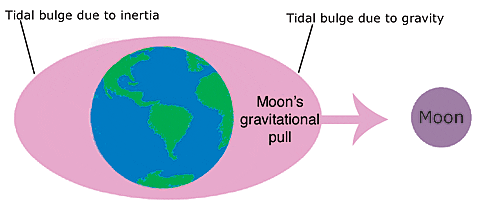Tides and Water Levels
Gravity, Inertia, and the Two Bulges
The gravitational attraction between the Earth and the moon is strongest on the side of the Earth that happens to be facing the moon, simply because it is closer. This attraction causes the water on this “near side” of Earth to be pulled toward the moon. As gravitational force acts to draw the water closer to the moon, inertia attempts to keep the water in place. But the gravitational force exceeds it and the water is pulled toward the moon, causing a “bulge” of water on the near side toward the moon (Ross, D.A., 1995).
On the opposite side of the Earth, or the “far side,” the gravitational attraction of the moon is less because it is farther away. Here, inertia exceeds the gravitational force, and the water tries to keep going in a straight line, moving away from the Earth, also forming a bulge (Ross, D.A., 1995).

Gravity and inertia act in opposition on the Earth’s oceans, creating tidal bulges on opposite sites of the planet. On the “near” side of the Earth (the side facing the moon), the gravitational force of the moon pulls the ocean’s waters toward it, creating one bulge. On the far side of the Earth, inertia dominates, creating a second bulge.
In this way the combination of gravity and inertia create two bulges of water. One forms where the Earth and moon are closest, and the other forms where they are furthest apart. Over the rest of the globe gravity and inertia are in relative balance. Because water is fluid, the two bulges stay aligned with the moon as the Earth rotates (Ross, D.A., 1995).
The sun also plays a major role, affecting the size and position of the two tidal bulges. The interaction of the forces generated by the moon and the sun can be quite complex. As this is an introduction to the subject of tides and water levels we will focus most of our attention on the effects of the stronger celestial influence, the moon.
Tides and Water Levels
